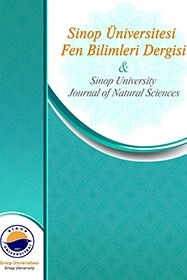Gazbetonun Malzemesinin Isıl İletkenliğinin Farklı Gözeneklilik Oranlarında İncelenmesi
Binalarda ısınma maliyetlerinin azaltılması için uygun yapı elamanları kullanarak yalıtım yapılmalıdır. Bu açıdan gazbeton yapı sektöründe çok önemli bir yere sahiptir. Gazbeton gözenekli yapıya sahip hafif beton sınıfında yer alan bir yapı malzemesidir. Bu çalışmada gazbeton malzemesinin gözeneklilik oranına bağlı olarak ısıl iletkenlik değeri analitik, sayısal ve deneysel olarak belirlenmiştir. Analitik inceleme yapılırken gözenek oranları dikkate alınarak literatürde yer alan ısıl iletkenlik hesap modelleri kullanılmıştır. Sayısal incelemede elektron mikroskopta elde edilen görüntüler (SEM) kullanılarak gazbetona ait geometrik model oluşturulup tek boyutlu çözümler elde edilmiştir. Gazbetonda kireç, çimento ve alüminyum tozunun reaksiyona girmesi nedeniyle kabarcıklar oluşmaktadır. Sayısal çözümler yapılırken hava kabarcıklarının ısıl iletkenliğinin sıcaklığa bağlı olarak değiştiği, kuvarsitin sıcaklıkla değişmediği değerler kullanılmıştır. Sayısal çözümlerde sonlu eleman esaslı (ANSYS) programı kullanılmıştır. Çözümlerde sabit yüzey sıcaklığı sınır şartları altında ısı akısı hesaplanmıştır. Deneysel çalışmalar Laser Flash teknoloji kullanan cihazla farklı gözeneklilik oranlarında yapılmıştır. Çalışmanın sonunda analitik, sayısal ve deneysel sonuçlar karşılaştırmalı olarak verilmiştir.
Anahtar Kelimeler:
Gazbeton, Isıl İletkenlik
___
- [1] Budaiwi, A. Abdou, M. Al-,homoud, Variations of thermal conductivity of insulation materials under diffirent operating temperatures:impact on envolope-induced cooling load, Journal of Archaelogicial Engineering 8 (4) (2002) 125-132.
- [2] Hong-Qing Jin, Xiao-Li Yao, Li-Wu Fan, Xu Xuc, Zi-Tao Yu,Experimental determination and fractal modeling of the effective thermal conductivity of autoclaved aerated concrete: Effects of moisture content,International Journal of Heat and Mass Transfer 92 (2016) 589–602
- [3] Y.E. Cicek, Ph.D. Thesis, Istanbul Technical University, Turkey (2002).
- [4] S. Kartal, Ph.D. Thesis, Trakya University, Turkey (2001).
- [5] Z. Pehlivanli, R. Calin, I. Uzun, Effect of moisture and temperature on thermal conductivity of G2/04 class autoclaved aerate concrete, Asian J. Chem. 22 (2010) 4104–4110.
- [6] A, Kılıç, C.D.Atis, E.Yaşar, Özcan, High-strenght ligtweight concrete made with scoria aggregate containing mineral admixtures, Cement Concrete Research 33 (10) (2003) 1595-1599.
- [7] G.M. Glenn, G.M. Gray, W.J. Orts, D.W. Wood, Starch-based lightweight concrete: effect of starch source processing method and aggregate geometry, Industrial Crops and Products 9 (2) (1999)133-144.
- [8] A. Bouguerra, A. Ait-Mokhtar, 0. Amiri, M. B. Diop, “Measurement of thermal conductivity, thermal diffusivity and heat capacity of highly porous building materials using transient plane source technique” Heat Mass Transfer, 28, 1065-1078, (2001).
- [9] Kadashevich, H.-J. Schneider, D. Stoyan, “Statistical modeling of the geometrical structure of the system of artificial air pores in autoclaved aerated concrete”, Cement and Concrete Research, 35, 1495, (2005)
- [10] N. Narayanan, K. Ramamurthy, Structure and properties of aerated concrete: a review, Cement Concrete Composite 22 (2000) 321–329.
- [11] A.D. Stuckes, A. Simpson, The effect of moisture on the thermal conductivity of aerated concrete, Build. Serv. Eng. Res. Technol. 6 (1985) 49–53.
- [12] J.P. Laurent, An estimation model for the dry thermal-conductivity of autoclaved aerated concrete, Mater. Struct. 24 (1991) 221–226.
- [13] J.P. Laurent, C. Guerrechaley, Influence of water-content and temperature on the thermal-conductivity of autoclaved aerated concrete, Mater. Struct. 28 (1995) 464–472.
- [14] C. Boutin, Thermal conductivity of autoclaved aerated concrete: modelling by the self-consistent method, Mater. Struct. 29 (1996) 609–615.
- [15] M.S. Goual, A. Bali, M. Quéneudec, Effective thermal conductivity of clayed aerated concrete in the dry state: experimental results and modelling, J. Phys.D Appl. Phys. 32 (1999) 3041–3046.
- [16] D. Gawin, J. Kosny, A. Desjarlais, Effect of moisture on thermal performance and energy efficiency of buildings with lightweight concrete walls, in: 2000 ACEEE Summer Study on Energy Efficiency in Buildings Efficiency, Panel 3:Commercial Buildings: Technologies, Design, and Performance Analysis,August 20–25, 2000, Pacific Grove, California, USA, 2000.
- [17] B. Bhattacharjee, S. Krishnamoorthy, Permeable porosity and thermal conductivity of construction materials, J. Mater. Civ. Eng. 16 (2004) 322–330.
- [18] M. Albayrak, A. Yörükog˘lu, S. Karahan, S. Atlıhan, H.Y. Aruntas_, _I. Girgin, Influence of zeolite additive on properties of autoclaved aerated concrete,Build. Environ. 42 (2007) 3161–3165.
- [19] M. Jerman, M. Keppert, J. Vy´ borny´, R. Cˇerny´ , Hygric, thermal and durability properties of autoclaved aerated concrete, Constr. Build. Mater. 41 (2013) 352–359.
- [20] M. Campanale, M. Deganello, L. Moro, Effect of moisture movement on tested thermal conductivity of moist aerated autoclaved concrete, Transp. Porous Media 98 (2013) 125–146.
- [21] Soon-Ching Ng, Kaw-Sai Low, Thermal conductivity of newspaper sandwiched aerated lightweight concrete panel, Energy and Buildings 42(2010) 2452-2456
- [22] Kaw-Sai Low, Soon-Ching Ng, and Ngee-Heng Tioh, Thermal conductivity of soil-based aerated lightweight concrete, KSCE Journal of Civil Engineering (2014) 18(1):220-225.
- [23] N. Narayanan, K. Ramamurthy,Microstructural investigations on aerated concrete,Cement and Concrete Research 30 (2000) 457± 464
- [24] Pehlivanlı Z.,”Gazbeton Malzemesinin Farklı Sıva Malzemeleriyle Birlikte Isıl Özelliklerinin Nem ve Sıcaklıkla Değişiminin İncelenmesi” Doktora Tezi, Kırıkkale Üniversitesi, (2011)
- [25] B.Doğan, N.Çekel, Two-Dimensional And Numerical Analysis Of Sialon-Based Cutting Tips Thermal Conductivity By Using Sem Images, International Interdisciplinary Journal of Scientific Research Vol. 1 No:2 (2014).
- ISSN: 2536-4383
- Başlangıç: 2016
- Yayıncı: -
Sayıdaki Diğer Makaleler
Sinop Yarımadası Kıyıları (Güney Karadeniz, Türkiye) Makroalg Topluluklarının Zamansal Değişimi
Ali KARAÇUHA, Gökhan YILDIZ, Melek ERSOY KARAÇUHA
Uçucu Kül ve Silis Dumanlı Betonların Mekanik Özelliklerinin XRD ile İncelenmesi
Burhan UZBAŞ, Abdulkadir Cüneyt AYDIN
Sunay TÜRKDOĞAN, Serkan DİLBER, Barış ÇAM
Olasılıksal Yöntemler ile Türkçe Metinlerin Anlamsal Benzerliğinin Belirlenmesi
Gazbetonun Malzemesinin Isıl İletkenliğinin Farklı Gözeneklilik Oranlarında İncelenmesi
